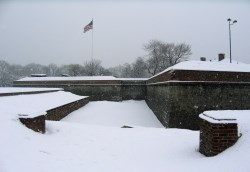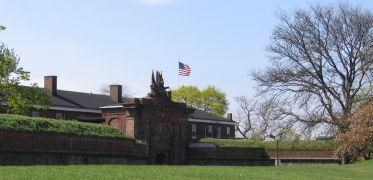
Andrew Moore, NPS Fort Jay is located on Governors Island in New York Harbor, one half-mile from the southern tip of Manhattan. No defensive works are known to have been erected on the island during its early history. Defensive earthen works were first erected on the highest point of Governors Island by Continental troops in 1775-76. The island and its fort were occupied by the British during the American Revolution until 1783, when it was surrendered, along with several buildings, to the Governor of New York. More than 10 years passed before renewed tensions with Great Britain resulted in funding from both the New York Legislature and the United States Congress in 1794 to reconstruct the works on Governors Island. This was part of a larger national effort to fortify ports that later became known as the First American System of coastal fortifications. Design of the New York Harbor defenses was assigned to French engineer Charles Vincent. The works on Governors Island had been completed by 1796, described in January of that year by the Secretary of War as "a fort made of earth, and two batteries under its protection, partly lined with brick masonry, two air furnaces, a large powder magazine, and a barrack for the garrison." Fears of a French invasion in 1797 resulted in a second- phase effort funded by additional appropriations to complete and enhance the coastal fortifications, including those on Governors Island. The fort is said to have acquired the name "Fort Jay" in 1798 for John Jay, then Governor of New York State. Governors Island and its fort were conveyed to the federal government two years later, in 1800, by an Act of the New York State Legislature. A plan of the fort as it existed that year shows it as a four- bastioned form surrounded by a ditch with a parapet having 51 embrasures, a gate and bridge on the east side, and a large magazine in the northeast bastion. The fort was still incomplete and incapable of defense in 1802, according to a written report, although it was then equipped with a "handsome Gateway with a Corps de Garde," or guardhouse, that survives today. 
Adam Ramsey, NPS Fort Jay had fallen into ruinous condition by 1806 when a second national campaign to strengthen the coastal defenses of the country, now known as the Second American System of fortifications, was implemented. This effort differed from the first by employing American engineers and using more durable masonry construction. The engineer chosen to design and oversee the defenses of New York Harbor was Colonel Jonathan Williams, Chief Engineer of the Corps of Engineers and first Superintendent of the Military Academy at West Point. Reconstruction of Fort Jay, renamed Fort Columbus about this time, began in July 1806 and was completed by December 1809. The only components of the old fort judged worth saving were "the walled Counterscarp, the Gate, the Magazine, and the Barracks," according to Colonel Williams in a report dated November 1808. The completed fort was described in a later report to Congress as "an enclosed pentagonal work, with four bastions of masonry, calculated for one hundred guns, fifty- five mounted, with brick barracks for two hundred and thirty men, including officers. [And] a stone and brick magazine…." Also constructed at this time was Castle Williams, a circular defensive work made of red sandstone that was erected on the west point of the island between 1807 and 1811. The earliest known plan of the completed fort is a plan by Joseph Mangin drawn in 1813. The first significant repairs and alterations were made to Fort Columbus in the 1830s, resulting in the overall appearance of the fort as it exists today. The stone retaining walls were extensively rebuilt at this time, including the scarp that was faced with granite and topped with a new brickwork parapet. The old magazine in the northeast bastion was demolished and replaced by four new magazines erected in the north ravelin. Finally, the four existing brick barracks were replaced by four new barracks with flanking triangular structures and outdoor courtyards. Later changes have been made to the barracks by the U.S. Army over the years, including interior remodeling and replacement of the flat roofs with hipped roofs in 1855- 57, incorporation of five of the triangular buildings as additions in the 1860s and 1898- 99, and reconfiguration of the buildings as officers' apartments in 1921- 22 and again in the 1930s. Paint was stripped from the exterior brick buildings in the 1930s, the sodded glacis of the fort was converted to recreational use as a golf course by 1940, and the flagstaff was moved from the northwest bastion to the north ravelin by 1953. Jurisdiction of Governors Island passed from the U.S. Army to the U.S. Coast Guard in 1966. Improvements made by the Coast Guard to Fort Jay, whose name was officially reinstated in 1904, included expansion of the golf course; remodeling of the barracks with new kitchens, bathrooms, heating and electrical systems, and storm windows and doors; and erection of chain- link fencing on the glacis. Fort Jay has sat vacant with minimal upkeep since closure of the Coast Guard base in 1997. 
NPS Fort Jay was recorded by the Historic American Buildings Survey in 1934 and in 1982- 83. The fort was individually listed in the National Register of Historic Places in 1974. It was included in a National Historic Landmark District designated in 1985, and a New York Historic District designated in 1996. The fort is also located within the boundaries of Governors Island National Monument, created by Presidential Proclamations signed in 2001 and 2003. The period of significance for Fort Jay spans the years 1794- 1966, as defined by the National Register of Historic Places. |
Last updated: September 26, 2018
